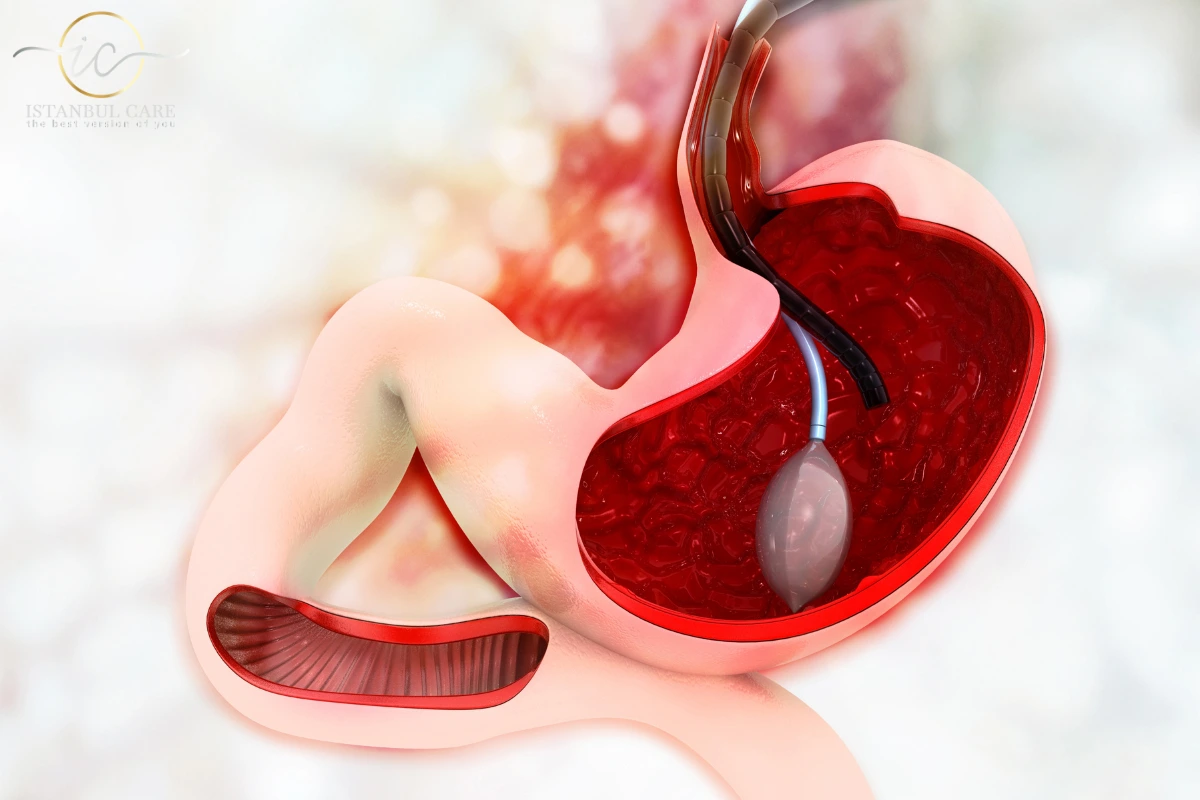Gastric balloon procedures in Turkey are a non-surgical and effective weight loss solution for those struggling with obesity. This minimally invasive procedure helps individuals reduce their food intake, making them feel full faster. With affordable prices, experienced surgeons, and high-quality medical facilities, Turkey has become one of the most sought-after destinations for gastric balloon treatments.
What Is a Gastric Balloon?
A gastric balloon, also known as an intragastric balloon, is a temporary weight loss aid placed inside the stomach to restrict food intake. It helps people lose 10-20% of their total body weight in a short period. Unlike other weight loss surgeries, it does not require permanent alterations to the stomach or intestines.
How Does the Intragastric Balloon Work?
The intragastric balloon creates a feeling of fullness by occupying space in the stomach. This reduces food intake and helps patients lose weight with a balloon without undergoing a surgical procedure.
How Is the Gastric Balloon Inserted?
The gastric balloon procedure is quick and non-surgical, taking about 20-30 minutes. It involves:
- Insertion: A deflated balloon is passed through the mouth into the stomach via an endoscope.
- Inflation: The balloon is filled with a sterile saline solution or gas.
- Completion: The inflated balloon remains in place for 6-12 months, helping control food intake.
How Long Does the Balloon Stay in Place?
- Standard gastric balloons last 6 months.
- 12-month gastric balloon options are also available for extended weight loss support.
Who Is a Candidate for the Gastric Balloon?
A gastric balloon is ideal for individuals who:
✔ Have a Body Mass Index (BMI) between 30 and 40
✔ Struggle with losing weight through diet and exercise
✔ Want a non-surgical weight loss procedure
✔ Are not eligible for more invasive procedures like gastric bypass
Who Is a Candidate for the Orbera Gastric Balloon?
The Orbera balloon is one of the most popular weight loss balloon options. It is recommended for those who need significant weight reduction and are committed to long-term lifestyle changes.
How Much Weight Can I Expect to Lose?
Patients undergoing balloon for weight loss treatment typically lose 10-20% of their body weight within 6 months. The final result depends on:
- Dietary habits
- Physical activity levels
- Overall lifestyle changes
Gastric Balloon – No Incision, Successful Weight Loss Alternative!
One of the key benefits of the gastric balloon is that it does not involve surgery, incisions, or scars. The procedure is fully reversible, and patients can resume normal activities within a few days.
How Is a Gastric Balloon Different Than Other Weight Loss Programs?
Unlike gastric bypass or stomach surgery to lose weight, a gastric balloon offers:
✔ No Permanent Changes – The stomach remains intact.
✔ No Long Recovery – Most patients recover within a few days.
✔ No Surgical Risks – No cutting or stitching is involved.
How Much Does a Gastric Balloon Cost in Turkey?
Gastric balloon procedures in Turkey are more affordable compared to the US and Europe.
| Country | Average Cost |
|---|---|
| Turkey | $1,200 – $3,500 |
| USA | $6,000 – $9,000 |
| UK | £4,000 – £6,500 |
12-Month Gastric Balloon Price in Turkey
For longer weight loss support, 12-month gastric balloons cost between $2,000 and $4,000 in Turkey.
Standard Packages
For Gastric Balloon in Turkey, you will stay 0 nights in the hospital + 2 nights in a VIP hotel
- Accommodation in a VIP hotel
- All transfers between the airport and hotel with a VIP car
- All internal transfers between the hotel and hospital
- Medical consultation and examination
- Preoperative evaluation and tests
- Outpatient procedure (no hospital stay required)
2 follow-up appointments with the doctor after the procedure
- Anesthesia (if required)
- Nursing care facilities
- Medical equipment
- Medications
- Post-procedure check-up and post-operative instructions
- Final check-up before departure
- Lifetime assistance
Density Boost
- Consultation & Hairline planning by Our Plastic Surgeon
- DHI or Sapphire FUE hair transplant surgery after an online consultation with a consultant
- 1. Day: The SVF stem cell treatment, which is performed by extracting from the abdomen, is carried out by pur plastic surgeon (stem cell hair treatment using abdominal fat, which has more stem cells boosts hair growth density.)
- 2. Day: Operation is done by a team of Hair Transplant Specialists under the supervision of our Plastic Surgeon
- Exsome Hair Therapy to stimulate hair growth and improve scalp health
- Prp ( One session)
- Laser hair regrowth treatment (one session.) FDA-approved laser devices for treating pattern hair loss and androgenic alopecia are available exclusively at Este Medical Group.
- Sedation ( No pain during the numbing process)
- Blood tests
- All the required medications
- 6-month Aftercare supplements
- 5-star Hotel Accommodation (3 Nights)
- Check up and first wash on the following day
- Travel Health Insurance: Travel confidently—protect your hair transplant journey. Stay covered for any illness or injury abroad.
- Personal translator available at all times
- Airport and internal transfers
- 12 months of online post-operation follow-ups.
What Happens After the Procedure?
After gastric balloon surgery, patients must adjust their diet and lifestyle. The first few days may involve some discomfort, but most return to normal activities within a week.
What to Eat After the Operation?
✔ First Week – Liquids and soft foods
✔ Weeks 2-4 – Pureed and soft solid foods
✔ After One Month – Regular meals in smaller portions


Speak with our expert Gastric Balloon specialists
We’re ready to answer your questions
What Happens During the Procedure?
✔ Preparation – Patients undergo a medical evaluation.
✔ Insertion – The balloon is placed using an endoscope.
✔ Inflation – It is filled with liquid or gas.
✔ Completion – The entire balloon gastric procedure takes under 30 minutes.
What Happens After the Procedure?
After gastric balloon surgery, patients must adjust their diet and lifestyle. The first few days may involve some discomfort, but most return to normal activities within a week.
What to Eat After the Operation?
✔ First Week – Liquids and soft foods
✔ Weeks 2-4 – Pureed and soft solid foods
✔ After One Month – Regular meals in smaller portions

Gastric Balloon Removal – How Is the Balloon Removed?
After six months (or 12 months for extended versions), the balloon is removed endoscopically.
✔ Deflation – The balloon is punctured and deflated.
✔ Extraction – It is safely pulled out through the mouth.
✔ Follow-up – Patients continue with nutritional support.
Are There Any Risks Involved with a Gastric Balloon Procedure?
The gastric balloon is a safe and reversible weight loss method. However, some side effects may occur.
Gastric Balloon Side Effects:
✔ Nausea and vomiting (common in the first few days)
✔ Acid reflux or discomfort
✔ Mild abdominal pain
These symptoms typically subside within a week as the body adjusts.
Life After the Gastric Balloon
✔ Maintain a Healthy Diet – Avoid high-calorie foods.
✔ Exercise Regularly – Engage in low-impact activities like walking or swimming.
✔ Follow-Up Visits – Monitor progress with your specialist in Turkey.
Frequently Asked Questions
Yes, it is a FDA-approved, non-surgical procedure performed by experienced specialists in Turkey.
The stomach starts adjusting within 2-3 weeks, leading to a natural stomach shrinking effect.
✔ Orbera Balloon – Most commonly used 6-month balloon.
✔ Allurion (Elipse) Balloon – Swallowable, no endoscopy required.
✔ Spatz3 Balloon – Adjustable 12-month option.
With the gastric weight loss balloon, stomach capacity decreases within weeks, promoting faster weight loss.
Most patients return to work within 2-3 days after the balloon for weight loss procedure.
✔ Gastric bypass
✔ Sleeve gastrectomy
✔ Weight loss medication
✔ Non-surgical weight loss programs
Yes, if needed, patients can have a second balloon inserted after a break.





